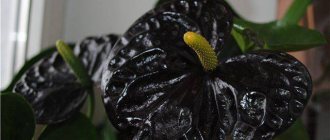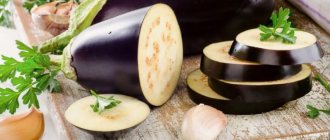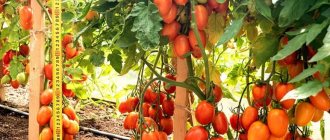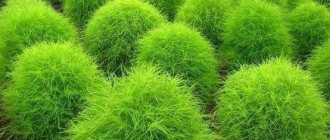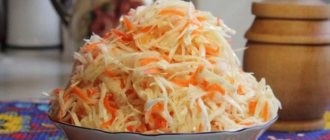Advantages and disadvantages
This planting method is ideal for amateur gardeners, since seedlings of all crops are placed on one windowsill.
Advantages of this planting method:
- Seedlings do not take up much space. This is especially important when plants need to be placed near a heat source or illuminated with special lamps.
- Easy to plant and care.
- Saving soil mixture.
- In such a container you can grow seedlings without soil: lay out several layers of toilet paper on a laminate base. Plants cannot remain without nutritious soil for a long time, therefore, after the appearance of cotyledon leaves, they must be planted in diapers.
- Planting seeds using a soilless method protects future shoots from the “black leg”.
- When picking, it is impossible to damage the root. Since it is enough to unwrap the snail and take out the young shoot.
- In it, the sprouts receive the same amount of light, so they do not need to be constantly rearranged.
- You can dive one at a time - strong plants first, and leave weak shoots for growing.
- No expensive materials are required to create snails and diapers. You can use the substrates for several years.
In addition to the advantages, there are some disadvantages:
- Sowing requires serious concentration, which is especially difficult for beginners.
- There is no clear decision on what material should be used to create a snail.
- Agronomists believe that there is too little soil for the development of a normal root system.
Snails are suitable for growing vegetable, ornamental and berry crops. If the seedlings stretch upward and their stems become thinner, then they need to be illuminated with special lamps.
What are diapers and snails for seedlings
Snails for seedlings are a modern way to grow almost any plant. An inexpensive design that takes up minimal space allows you to fit on one windowsill all the crops that would previously have filled an apartment, a balcony, or even a cat’s bed. Diapers are small bundles of fabric or cellophane into which grown seedlings are planted. These personal packages are made from scrap materials, take up little space and make it easier to plant plants in a permanent place.
Materials for creating a snail and a diaper are sold at any hardware or hardware store, and creating the structure does not require physical strength, special skills or tools.
Necessary materials for making a snail
Making a snail for seedlings with your own hands is easy.
First you need to prepare some things:
- substrate, it should be no thicker than 2 mm;
- two-layer toilet paper;
- soil – it should be light and well-watered;
- seeds of the desired crop;
- container with water;
- tweezers, which are used for sowing seeds;
- a plastic bag or cling film to create a greenhouse effect in the snail;
- thin tape or an elastic band for money, you will need them when you need to secure the roll;
- a transparent container in which the elastic structure will stand;
- sawdust to avoid excess moisture;
- sprayer, scissors, small shovel, knife;
- Labels for identifying varieties.
Having prepared all the necessary materials in advance, you can begin making the snail.
Sowing tomato seeds into a snail in different ways
Almost all gardeners grow tomatoes; their seedlings can be sown not only in pots, but also in a snail. Let's look at several ways to plant tomato seedlings in a snail:
- Sowing tomatoes in a snail without soil
Tomatoes can be sown in toilet paper or napkins, but grown sprouts need to be transplanted into a more nutritious environment, otherwise they will not be able to develop normally.
- Sowing tomatoes in a snail with soil
Tomatoes can also be sown in a snail with soil; in this case, you can do without intermediate picking. The snail can be planted directly into open ground.
- Picking in diapers
If you decide to carry out the picking procedure, you can transplant them into diapers. This is also a convenient method that simplifies planting in open ground.
Tomato seedlings in a snail
X
How to prepare seeds before planting
To get ideal seedlings, it is not enough to buy planting material and sow it. First you need to sort and sort the seeds. This will help get rid of low-quality planting material and preserve usable area.
Several ways to treat seeds before sowing:
- Germination on a well-moistened napkin or gauze. This encourages them to grow quickly. It is important to remember that warm water is suitable for these purposes.
- Soaking in a container with beneficial micronutrients to provide sufficient nutrition and increase the vigor of the sprout.
- Disinfection. Treatment of seeds in a solution of potassium permanganate.
It has been proven that proper seed preparation promotes good germination.
What it is?
Any gardener knows how quickly space on the windowsill runs out when installing boxes with seedlings there. And if there are still indoor flowers there, then temporary difficulties begin to look more like a disaster. The problems don't end there. Containers with soil can be repeatedly turned over by children and pets, which adds to the hassle of cleaning.
Traditional planting of seedlings requires quite frequent watering; skipping this event can quickly destroy young seedlings. And watering itself requires you to spend a lot of time to bring moisture to each plant.
Planting in snails and diapers easily solves these problems. A simple and convenient design made from scrap materials allows you to save a lot of time by fitting almost all the seedlings on one windowsill.
Snails are most often constructed from the construction substrate left behind the laminate after repairs. Pieces of plastic film are used as diapers. Rolling a snail or a diaper is very easy; this method does not require special skills. Just read about it or watch the video once and you will succeed.
Initially, the seeds are sown in snails - rolled material rolled in a circle, between the layers of which the seeds will germinate. In a small area you can easily place two dozen such structures, and even more.
When picking, the seedlings are transferred to diapers - individual packages placed in a common container. Caring for such seedlings will be much easier, and when subsequently planted in open ground, the roots will not suffer damage, which will allow the plants to adapt faster.
Snail for seedlings. Where to start: video
Step-by-step instructions for making a snail
The above materials should be placed on the table.
How to twist a snail for seedlings:
- Cut the backing into thin strips. If the plant is replanted after the appearance of cotyledon leaves, then a strip 10 cm wide is sufficient. If they grow in this way before planting in open ground, then the strip should be 10-15 cm.
- Add soil. The soil layer should not exceed 1 cm.
- Seeds are usually placed at a distance of 1-2 cm from the edge. A few centimeters are also left between them.
- The tape with soil and seeds is rolled up and secured with an elastic band or thin tape.
- The resulting snail must be shed with water.
- Then put on a plastic bag to create a greenhouse effect.
- When placing the packages in a container, remember that the seeds should be at the top.
- After the first shoots appear, the package can be removed.
Following these recommendations step by step, the gardener should not forget to stick labels on packages with different crops. It will take him no more than 15 minutes to roll one roll.
How to make a snail correctly
Before you start making a snail, you need to learn everything about how to make it correctly and what materials to use.
Materials for production
First of all, you will need the material from which you will make the snail. It should be foamed polyethylene, approximately 2 mm thick. This material has many advantages: it is cheap, bends well and allows air to pass through, and holds its shape well. Also, for fastening, rubber bands are needed, which are used to fasten money or construction tape.
Also, prepare scissors and a container with prepared soil. You can also use multi-layer toilet paper or napkins as a primer.
Materials for making a snail - 2 mm backing for laminate, sprouted seeds, soil and rubber bands for attaching the snail
How to plant seedlings in a snail
To create a snail, you need to cut the polyethylene with scissors, the width of the tape is 10-15 cm, and you choose the length yourself, it should depend on how many seeds you want to plant in one snail.
Do not make the tape too long (no more than 1-1.5 meters), the snail should not be very thick.
Place the previously prepared soil and seeds on the ribbon, then carefully twist the snail and secure it with rubber bands.
Do not forget that planting material and soil must undergo a disinfection procedure, this reduces the risk of developing any diseases.
Cut out the backing
spread the soil and seeds
roll up and secure the snail with an elastic band
What crops can be grown using this method?
Since this is an easy-to-use method of planting vegetables, berries and flowers, it is being used more and more often. Seedlings are grown using the snail method for crops such as: tomato, zucchini, pepper, cucumber, eggplant, cabbage, strawberries and flowers.
How to plant cabbage seeds
You can plant cabbage in soil mixture and toilet paper. Particular preference is given to the latter option, since there may be pests and rot in the soil.
To sow cabbage, you need:
- cut strips 10 cm wide from the substrate;
- put toilet paper strips on them;
- moisten with water;
- sow cabbage seeds at a distance of 2 cm from the edge and 2.5 cm from each other;
- roll into rolls and secure with tape;
- Cover the top with a plastic bag and place in a container with sawdust.
After the first leaves appear, the cabbage sprouts can be transplanted into diapers.
How to get tomato seedlings
Growing tomatoes in a snail is very convenient.
Here are some benefits:
- this method does not require daily watering;
- the root system develops well;
- plants practically do not stretch;
- It takes a few minutes to pick the tomatoes.
Planting tomatoes requires the same steps as when planting other vegetable crops.
Growing flowers in a snail
This method can be used to grow not only vegetables, but also some flowers. For example, planting petunia in a container is not difficult, but picking it out can be a real problem. Therefore, planting in a snail will help keep the roots of the flower intact.
To get a flower for seedlings, you need to sow the seeds in the ground and wrap them in a roll. For the best effect, put a plastic bag on top.
In addition to petunias, marigolds can be grown in a snail. You can use the traditional germination method. Before planting, the seeds must be soaked in a saucer of water, covered with cling film and placed in a warm place. Marigolds are grown similarly to other plants - both on the ground and on toilet paper.
The same method can be used to grow annual dahlias, daisies and bluebells.
Sowing pepper into a snail without picking
The twist should be 15-17 cm high.
Place the sprouted seeds at a distance of 2 cm. There is no need to sow thicker: the pepper seedlings will shade each other and stretch out.
When planting pepper, keep in mind that it does not like picking. Keeping this in mind, increase the distance between seeds.
Fill the soil mixture with a layer of 1-1.5 cm on top. Compact it slightly. Water the pepper crops carefully, making sure that the seeds are not washed onto the surface of the soil. Place labels with the names of the varieties. To prevent moisture from evaporating too quickly, place the crops in a greenhouse or in a bag. The temperature must be maintained at +25°C.
With the emergence of seedlings (5-7 days), place the crops in a bright place with a temperature of +15-17°C. Water with warm water sparingly, making sure that water does not accumulate in the pan. To prevent the seedlings from leaning towards the light, rotate the bowl with the seedlings relative to the window or illuminate them with a phytolamp.
Features of caring for seedlings
It is not enough to simply sow seeds and wait for the first shoots to appear.
To obtain healthy seedlings, you need to fulfill a number of conditions:
- The container with rolls must be placed in a warm and sunny place.
- Regularly remove polyethylene and ventilate.
- After the first shoots appear, the film should be removed.
- Until they hatch, they can be watered from above. When the root gets stronger and grows, then water can be poured into the bottom of the container.
- You can only spray from above with a spray bottle.
- As the seedlings grow, new soil can be added to the snail. This will give the plants more nutrients.
After the sprouts have become stronger, they can be planted in new containers. A polyethylene diaper is perfect for this.
Difficulties in growing seedlings in a snail
- When growing, use additional lighting to prevent the seedlings from stretching.
- Do not forget to remove the film immediately after the first shoots appear.
- Picking seedlings from a snail should be done after two true leaves appear or if the roots peek out from the bottom of the snail. You can unwind the snail, remove the most developed seedlings, and leave the rest for further growth.
- The grown seedlings are transplanted into separate cups; by the way, they can also be made from a substrate.
Common Mistakes
When mastering a new method, it is difficult to resist doing everything your own way.
Here are some of the most popular mistakes made when growing seedlings this way:
- Pulling seedlings. The reason for this phenomenon may not be a lack of lighting, but the late removal of cellophane from the packages. Plants, being in a greenhouse for a long time, begin to grow rapidly. This has a detrimental effect on further development and fruiting. Therefore, it is better to remove the polyethylene as soon as the first shoots appear.
- Don't rush into picking. If you disturb the plant too early, it will hurt for a long time. It is better to start picking when the roots are visible at the opposite end of the roll. A well-developed root system will help plants quickly take root in a new location and receive sufficient nutrients.
- It is important to remember that when rolling the roll should be tight. In a poorly secured bundle, the planting material, along with the soil, slides down. This affects the germination and growth of seeds, since the plant needs too much strength to reach the upper edge of the roll.
- Some gardeners do not recommend making a roll of toilet paper. Of course, it is possible to grow seedlings in a snail without soil, but it is better to place the seed directly on the laminate substrate. They believe that swollen paper slows down growth or completely prevents seeds from hatching.
- Care should be taken to ensure that the edge with the seeds does not end up at the bottom of the container.
- You should not skimp on materials, since you should not plant seeds on cellophane instead of a substrate that retains moisture well.
Without following the recommendations, you may simply not wait for the shoots to emerge and ruin the entire sowing season.
Technology for growing soilless seedlings
Not all beginning gardeners know that it is possible to sow seeds for seedlings in a snail without using soil. The soil is easily replaced with toilet paper or other napkins.
But, if you are planting seedlings without the participation of soil, then you need to dive in a timely manner, otherwise the sprouts will begin to stretch.
The method of growing without soil is considered simpler, but it is used only until sprouts appear, then they are transplanted into a more nutritious medium.
To sow seedlings without using land, you must:
- Toilet paper or napkins;
- Polyethylene tape;
- Scissors, ruler, spray bottle;
- Seeds.
Seed planting scheme:
- Cut the tape into strips no more than 10 cm wide;
- Toilet paper is placed on the tape, which needs to be aligned along the top edge;
- Toilet paper is watered generously from a spray bottle;
- Place the seeds at a distance of 3-4 cm from each other, it is also necessary to retreat from the edges up to 5 cm;
- Place another layer of toilet paper on top and moisten it;
- Next, roll the tape into a snail and secure with rubber bands;
- The snail is placed on a tray; you can use a plate as a tray;
- You need to pour warm water into the plate, this is necessary to maintain the moisture of the paper;
- The snail must be covered with film;
- Place the tray with the snail in a dark but warm enough room;
- After the first shoots appear, the tray with them is moved to the windowsill in normal lighting.
Picking plants into other containers
Transplanting seedlings begins when the plants have grown to the desired size and visually look strong. Despite the same conditions, there may still be small plants in the roll for picking. Therefore, the roll is unwound and strong shoots are taken out, and small ones are left in the same place for growing. Picking will be easy, since the plants are located at a distance from each other and their roots do not intertwine.
After dividing into weak and strong bundles, they fold it back and return it to its usual place. Strong sprouts can be planted in a diaper.
Planting seedlings from a diaper into the ground
A common problem with plastic containers and cups for mature seedlings is that transferring them into the ground becomes a difficult process. The roots stuck to the walls of the container are torn, and it is almost impossible to get a lump of dense earth without damaging them.
Film diapers unfold even more easily than they are assembled, and the plant does not get injured. Just remove the elastic band, unwind the roll and send your “pet” to its permanent place along with the soil in the diaper.
Making diapers
Growing seedlings in snails and diapers is quite convenient. Their main advantage is saving usable space.
Therefore, it is very convenient to pick plants from the bundle into diapers:
- Most often, they use ready-made plastic bags (18 by 27 cm) or cut them out from film themselves (no larger than a notebook sheet).
- Soil is poured into the upper left corner. The root of the plant is placed on it and sprinkled with soil.
- There is no need to shorten the root system.
- The film is folded in half (from bottom to top) and rolled into a tube.
- The resulting package must be secured with an elastic band.
- Add water.
Place the plants in diapers vertically in a container. When the sprouts gain strength, they can be planted in open ground.
Growing seedlings in snails is attractive because of its economy, since the seeds germinate in a laminate substrate and in a soil mixture, and sometimes without any soil at all. Having mastered the intricacies of this method, you no longer need to clutter all the tables in the house with drawers. A small container is enough to fully satisfy your personal seedling needs.
Benefits of growing seedlings in a snail
The main advantage of sowing seeds into a snail
– this is the rational use of free space. That is, 10-15 sprouts fit in a snail, but only one sprout in a glass of the same diameter. This growing method is especially relevant for apartments in high-rise buildings.
It’s easy to make a snail yourself; the backing for the laminate is not expensive. Seedlings are also
, without damaging the root system, it is enough to unfold the snail.
Plants in the snail receive sunlight in the same amount; they do not need to be rotated like boxes with seedlings.
To grow seedlings in a snail, you will need much less soil; this is also important for a gardener, especially if there is not enough space to store the finished mixture in an apartment, for example.
Various vegetables and ornamental crops can be grown in snails
. Peppers, tomatoes, eggplants, zucchini, cabbage of any kind, flowers, leeks, and strawberries grow especially well in snails.
Preparing seeds for germination in a snail
Before you start planting, you should pre-sort the seeds. Empty seeds, those that are of the wrong color, or that are too small in size should be selected so as not to sow the precious area with previously rejected material. You can also use special techniques that help increase seed germination.
To stimulate germination of seeds, you can soak them in water. For these purposes, warm water is needed. The seeds are placed in gauze or bandage and soaked until they swell.
To harden the seeds, you can soak them in cold water for 24 hours, which should be changed after 3-4 hours.
To speed up the germination of seeds, you can soak them in microelements dissolved in water 10-12 hours before planting. This method is good because the resulting seedlings are of high quality and strength.
For these purposes, ultraviolet light and potassium permanganate are used. Onions and legumes can be placed under open sunlight or an ultraviolet lamp.
A 1% aqueous solution is prepared from potassium permanganate and water, into which the seeds should be placed for 20-30 minutes.
To disinfect seed, you can use garlic water: 20 grams of chopped garlic per 100 grams of water. It is recommended to keep the seeds in this solution for an hour. After the procedure, it is advisable to rinse the selected planting material.
When and how to plant in the ground?
Tomato seedlings are planted in snails in open ground in April-May. Seedlings must undergo a hardening procedure to reduce the risk of damage in the event of temperature changes. Plant seedlings early in the morning or in the evening. Do not perform this work in direct sunlight.
The snail must be carefully unfolded in order to remove the seedlings . Experts advise planting tomatoes as follows: maintain a distance of 50 cm between tomato bushes and 70 cm between rows.
After planting, it is advisable to create shade for the tomato seedlings so that they are not exposed to sunlight, which can adversely affect their development.
The essence of the method
Sowing tomatoes in snails is considered an effective way . With its use, there is no need to tinker with boxes or frequently water seeds and seedlings.
The essence of this original method is to save space and obtain strong seedlings.
Main nuances
Snail casting is an unusual method of laying soil and seeds for planting . How to plant tomato seeds with soil? In this case, the earth is initially poured onto a long strip made of various materials. This base, together with the soil, is carefully twisted, resulting in something like a stuffed roll.
Advantages and disadvantages
The advantages, in addition to saving space, are:
- good germination;
- free development of the root system;
- convenience when picking;
- the ability to regulate lighting as a result of turning the cochlea.
Watering seeds becomes easier. Water is poured into the container in which the snail stands, thereby keeping the soil constantly moist. You don't need a lot of soil for sowing . Even with the same care, seedlings grow differently. The snail, depending on strength and height, allows you to adjust the landing and picking.
The disadvantages of this method are that when there is a lack of lighting, the sprouts stretch out. In this case, additional lighting will be needed.
What is needed for a seedling “snail”: materials and machine
To collect a snail, you will need only two materials: good soil for seedlings with fertilizers and a strip of any material suitable for this purpose. The best choice would be Izolon, which is used for thermal insulation. It will maintain the temperature, in addition, foam polyethylene does not get wet and does not sprout. But you can replace it with polyethylene, a strip of ordinary kitchen oilcloth, a roll of garbage bags, and even linoleum.
Many who made the “snail” complained that this process was very garbage. The earth is crumbling in all directions. To prevent this from happening, you should use the idea of the channel’s author to create a special device for twisting seedling “snails”.
The machine looks very simple: these are two parallel boards screwed to the base
The height of the side in this machine is no less than 10 cm. You can do more if you are going to make large “snails”, but it’s not easy to place them on the windowsill
The distance between the sides is exactly 15 cm, this is, as was said, the optimal height of the “snail”
You only need to prepare an Isolon strip of suitable width and length of at least 3 meters
“Snails” are also made at a smaller height, for example, for seedlings of flowers or strawberries, 10 cm is enough, but for vegetable crops you need to use all 15 cm.
How to properly plant seeds in a snail?
First, you will need to prepare everything you need for planting and organize your workspace. To make a snail you will need:
- soft backing for laminate (sold in 1.5 m rolls);
- plastic bags;
- rubber bands for money, or twine;
- planting soil;
- seeds for seedlings;
- plastic transparent container with low sides;
- water bottle;
- tweezers.
You won’t need a lot of time; the process of making one snail will take about a quarter of an hour. The following procedure must be performed:
- Unfold the backing and place it on the table in front of you.
- Pour soil onto the material, level it and lightly press it down, you should get a layer 1cm thick.
- Having thus prepared an area 20 cm wide, begin to place seeds on it with tweezers closer to the top edge, leaving a distance of 1-2 cm to it. Mark this edge with a marker.
- The seeds should be located at a distance of 3-4cm from each other. Lightly press each of them into the ground with your finger.
- After the manipulations have been completed, carefully roll this section of the substrate into a roll and repeat all stages of work on the next free area.
- Using this method, fill the entire roll of backing tape with soil and seeds. At the end, tie the resulting package with an elastic band for money or twine, attaching a label with the name of the seeds.
- Pour plenty of water over the snail from a bottle and put a plastic bag on it, creating a miniature greenhouse. The edge near which the seeds were planted should be on top.
- Place the snail in the container and begin making the next design.
- Several snails are placed in one container at once, depending on its volume.
The container with snails is placed on the windowsill. The package is removed when the first shoots appear.
The advantages of this method include:
- Possibility of more uniform illumination. After all, it is easier to turn a container with snails on the other side towards the light than a bulky planting box full of soil.
- Saving money on purchasing soil for city residents. With this planting method, very little land is used.
- Reusable backing. After planting the seedlings, wash the film thoroughly and dry it. Next year you will not have to make new preparations.
- With proper care in the snail, seedlings develop a strong root system. In addition, picking from this design is lightweight and allows you to avoid injuring the roots.
It is not known exactly who the author of this original method is, but many summer residents have already adopted it and are grateful to the nameless inventor.
From the “snail” to the “diaper”
The twist, convenient for growing seedlings, is only suitable for germinating seeds. The sprouts that appear subsequently require picking.
Transplanting seedlings from a “snail” is performed with plants that have a developed root system. Twisting allows you to see when the roots appear under the bottom cut of the backing. Having noticed them, you can start picking.
Twisting has another convenience: you can remove the strongest sprouts from it first and wait until the remaining ones are also ready for transplanting. In this case, the twist is carefully unrolled by removing the elastic band or cutting the tape. Then the required sprouts are taken out, and the “snail” is carefully twisted and fastened again.
For picking, small cups (peat, paper). Or you can use an unusual method, popularly called a diaper. Its role is played by small plastic bags. Using them, you won’t have to waste time making paper bags at home or pay for special cups for seedlings made from peat.
The size of the bags depends on the height of the seedlings. For seedlings of medium height, it is convenient to use not very wide lunch bags.
Sequencing:
- Without opening the bag, place it on the table and pour a couple of handfuls of earth in the middle.
- Having unfolded the snail, we take out the plant, place it on the ground and lightly crush it. We carefully tuck the long roots.
- Add more soil and sprinkle the plant on top.
- We begin to “swaddle” the plant, twisting it so that we get a dense polyethylene cylinder, inside of which there is soil with a sprout.
- An excessively long package can be folded. But you should not make a polyethylene bottom, which will not allow excess moisture to leak out and can lead to rotting of the roots.
- The bag can be secured with an elastic band or tape. Some housewives do without it.
- We water the plant. The question of how to water does not arise. If dry soil is poured onto the bag, water more abundantly. If the soil is wet before the plant is placed on it, less water is required.
- We place the “swaddled” plant in the container. If possible, before installing the seedlings, add steamed sawdust to the bottom of the container.
The picking of seedlings is completed. Now you need to take care of it, preparing it for transplanting into the ground. Seedlings in a “diaper” make replanting less labor-intensive: the plant does not have to be removed from the cup: the bag simply unfolds.
Seedlings in film in pictures
Care
When planting tomatoes, it is necessary to take into account the nuances of care. Boxes with snails are placed in a bright and warm place where there is no draft. The film with which they are covered must be opened slightly so that everything is ventilated. As soon as the seeds begin to hatch, it must be removed immediately; there is no need to wait for sprouts to appear on all the seeds. All this time, watering is carried out from above, and when the roots can reach the pan, water is poured into it. You can also use a spray bottle, but so that under the running water the seed material and still weak sprouts do not go down to the bottom of the substrate.
We invite you to watch a video on how to care for tomatoes in snails:
Features of a snail made from a substrate
Growing seeds the Moscow way, when every centimeter of space is saved, is becoming more and more relevant. One of the new products in this area is seedlings in an original snail made from a laminate backing. This method is quite economical. But is it effective? Let's consider the advantages of a new folk invention:
- snail is easy to make;
- The “house” for seedlings is assembled from scrap materials. If you don’t have a substrate at home, you can buy it at an affordable price;
- space is saved;
- easy to dive without damaging the root system. To do this, just unroll the film.
- The roots are clearly visible, which allows you to sort the plants.
Underlay for laminate
Disadvantages:
- a new invention, untested by time. Therefore, the exact components of the snail, their size and picking time are selected experimentally.
What crops are suitable for germination in a snail? According to practitioners, growing vegetables and ornamental crops in a roll with a laminate backing is effective.
Experiments have already been successful with: tomatoes, eggplants, peppers, leeks. Strawberries, wild strawberries, zucchini, cabbage, and flowers also sprout together.
Snails from the substrate under the laminate
Picking seedlings in diapers from Yulia Minyaeva
Thus, you can grow excellent seedlings of almost any crop, even cabbage.
Planting seedlings in diapers:
1. It is better to use the film that was used to cover the greenhouse as a film, the main thing is that it is quite dense. We cut it into pieces the size of a notebook sheet, these will be our diapers into which the seedlings are subsequently planted.
2. Place a spoonful of prepared and moistened soil in the upper left corner of the film and place the sprout on it so that the cotyledons are above the edge of the film.
3.Then put a spoonful of soil on top.
4.Fold the bottom edge of the diaper and roll it up, putting on an elastic band to prevent it from unrolling.
5. We write the name of the variety or number on a piece of adhesive tape and stick it on the film.
6. We place all the rolls tightly in a tray without holes or some kind of container and leave it in a well-lit place.
